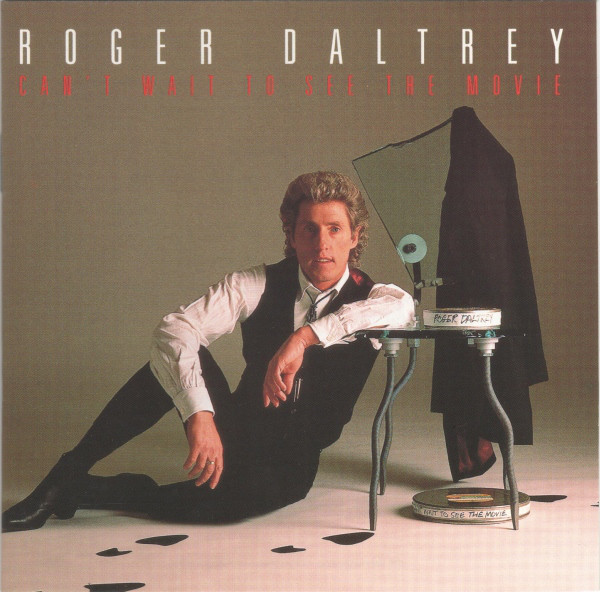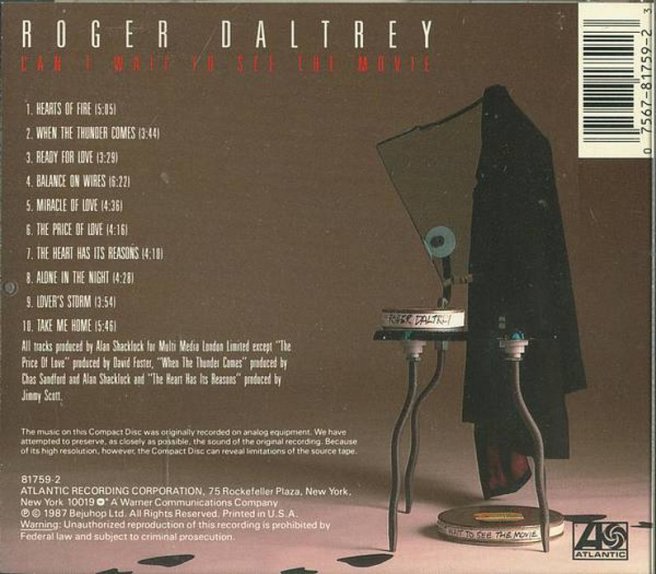
When I tentatively began exploring Roger’s solo catalogue in 2002, I was quite nervous and expected the worst. Thanks to the loud voices of the older guys on my Who mailing lists, I was led to believe it was hit-or-miss at best and embarrassing garbage at worst. Of course, the consensus on my estrogen Who lists was much different. As proudly tomboyish and gender-defiant as I’ve always been, I can’t deny the experience and opinions of male and female Who fans are often radically divergent!
I decided to sample Roger’s solo stuff because I was familiar with his voice and liked it very much. I had a general sense of what I’d be getting, despite how unreasonably nervous I used to be about trying anything new musically.

Roger himself understood early on he’d probably never be a huge solo star, and approached it as a fun hobby to pass the time and keep singing when The Who weren’t touring or recording their own albums. He didn’t do much marketing for his solo work, and didn’t even tour by himself.
All that aside, however, his solo albums aren’t nearly as bad as they’ve gotten the reputation of. The whole point of going solo, for many artists, is to try something new and break away from the type of music they made with their bands. Most of Roger’s solo albums don’t have a Who-like sound because that’s not what he was going for!

I will never understand so-called fans who whine and rant because a band or artist dared to experiment with a new style of music instead of spending their entire career constantly remaking their quintessentially greatest albums. No one is denying the strength and awesomeness of those records, but it would get really boring fast if all their songs sounded like mindless carbon copies. Many artists become one-hit wonders because their follow-up sounds way too much like that first big hit, and people laugh about it.
Roger also understood most Who fans weren’t wild about his solo albums, and that he was targeting a different type of audience. The voice is the same, but the songs aren’t. If you can recognise and respect that, you’ll probably enjoy his solo catalogue a lot more.
Hearing the worst and subsequently having very low expectations also helped me to like most of his albums far more than I thought I would. They’re not nearly as bad as I was falsely led to believe.

Just about everyone recommended McVicar first, since it’s a de facto Who album. Not only do Pete and John play and sing background vocals, but the songs also have a very Who-like feel. If you didn’t know this is a Roger solo album, you’d think it was The Who playing as The Who.
Another great place to start, or to go after McVicar, is Under a Raging Moon. It too has a very Who-like sound (which Roger was deliberately going for), and Pete even wrote the first track. As you might guess, the eponymous closing track is a tribute to Keith Moon.

My third-favourite album is One of the Boys, which was a hugely pleasant surprise. Every single song is a winner for me, and the album’s eclectic nature works for it instead of against it. Roger used a much wider group of songwriters than usual, so he wasn’t tied to just one style. This is perhaps his most criminally underrated album.
I also adore Can’t Wait to See the Movie, which is a marvellous trip down memory lane for me as a proud Eighties kid. While it has those trademark synths that musically defined my childhood decade, it’s not exclusively welded to that era like some other Eighties albums.

I couldn’t resist getting his eponymous 1973 début, since it was only $2 and Roger looks so beautiful and angelic on the cover. It makes no pretension of being timeless music or even a 5-star album, but it is a really fun listen. Not all music is meant to be serious and tailored to perfection. Sometimes you just want to kick back and listen to something lightweight, just as there are times you go for eating ice-cream and corn chips on the davenport instead of a five-course meal at a super-expensive restaurant.
Rocks in the Head is another fun romp, this time marked with the trademark style of the early Nineties. I only recently finally got acquainted with it, but it only took a few listens to start getting into it and really liking it.

Ride a Rock Horse is also a fun, rocking romp, but it’s never been one of my favourites. I appreciate and like it more now than I originally did, after listening to it again for the first time in many years, but it’s not what I’d personally recommend for someone just getting into his solo work. You always want to start with the strongest examples.
Parting Should Be Painless is his weakest solo effort, in my opinion. It’s not that the material is necessarily bad, just not presented in the strongest way. The individual songs would probably sound a lot better if they came up by themselves on the radio or a playlist, but they don’t work when collected on the same album. Even an album with a deliberately depressing theme should have more energy than this!

If you just want a sample of everything before committing to an entire album, you can try the greatest hits compilations Best Bits (1981), Best of Rockers & Ballads (1991), Martyrs & Madmen (1997), Anthology (1998), and Moonlighting: The Anthology (2005). Best Bits contains two previously-unreleased songs, “Treachery” and “Martyrs and Madmen” (#38 in the U.S.). “Say It Ain’t So, Joe” was also re-released and went to #41 in the U.S.
Roger sings lead on some of the songs on the Lisztomania soundtrack, which is a fair bit better than the movie.

In 2014, Roger released Going Back Home, a collaborative album with guitarist Wilko Johnson (who was fighting pancreatic cancer at the time). Another new album, As Long As I Have You, came in 2018. I’ve heard a few of their songs on auto-generated Spotify playlists, but have yet to listen to either in entirety.
I’m really glad I took a chance and gave Roger’s solo work a fair listen. While my preference will always be for The Who, followed closely by Pete’s solo work, there are a lot of treasures on Roger’s solo albums. They’re all worth multiple listens.













